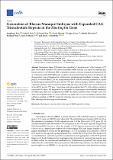Generation of Rhesus Macaque Embryos with Expanded CAG Trinucleotide Repeats in the Huntingtin Gene
Author(s)
Ryu, Junghyun; Statz, John P.; Chan, William; Oyama, Kiana; Custer, Maggie; Wienisch, Martin; Chen, Richard; Hanna, Carol B.; Hennebold, Jon D.; ... Show more Show less
Downloadcells-13-00829-v4.pdf (1.824Mb)
Publisher with Creative Commons License
Publisher with Creative Commons License
Creative Commons Attribution
Terms of use
Metadata
Show full item recordAbstract
Huntington’s disease (HD) arises from expanded CAG repeats in exon 1 of the <i>Huntingtin</i> (<i>HTT</i>) gene. The resultant misfolded HTT protein accumulates within neuronal cells, negatively impacting their function and survival. Ultimately, HTT accumulation results in cell death, causing the development of HD. A nonhuman primate (NHP) HD model would provide important insight into disease development and the generation of novel therapies due to their genetic and physiological similarity to humans. For this purpose, we tested CRISPR/Cas9 and a single-stranded DNA (ssDNA) containing expanded CAG repeats in introducing an expanded CAG repeat into the <i>HTT</i> gene in rhesus macaque embryos. Analyses were conducted on arrested embryos and trophectoderm (TE) cells biopsied from blastocysts to assess the insertion of the ssDNA into the <i>HTT</i> gene. Genotyping results demonstrated that 15% of the embryos carried an expanded CAG repeat. The integration of an expanded CAG repeat region was successfully identified in five blastocysts, which were cryopreserved for NHP HD animal production. Some off-target events were observed in biopsies from the cryopreserved blastocysts. NHP embryos were successfully produced, which will help to establish an NHP HD model and, ultimately, may serve as a vital tool for better understanding HD’s pathology and developing novel treatments.
Date issued
2024-05-13Department
Massachusetts Institute of Technology. Department of Brain and Cognitive Sciences; McGovern Institute for Brain Research at MITJournal
Cells
Publisher
MDPI AG
Citation
Ryu, J.; Statz, J.P.; Chan, W.; Oyama, K.; Custer, M.; Wienisch, M.; Chen, R.; Hanna, C.B.; Hennebold, J.D. Generation of Rhesus Macaque Embryos with Expanded CAG Trinucleotide Repeats in the Huntingtin Gene. Cells 2024, 13, 829.
Version: Final published version
ISSN
2073-4409